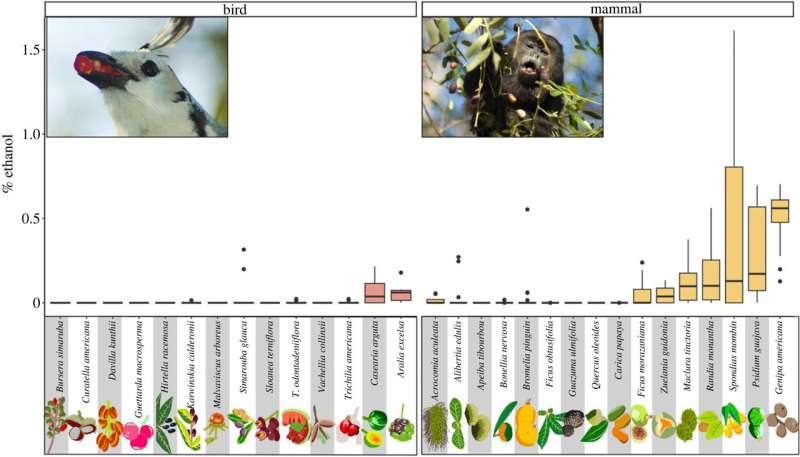July 20, 2023 report
This article has been reviewed according to Science X's editorial process and policies. Editors have highlighted the following attributes while ensuring the content's credibility:
fact-checked
peer-reviewed publication
trusted source
proofread
Wild fruits with higher alcohol content found to be more widely dispersed by mammals

A team of researchers from the University of Calgary, Área de Conservación Guanacaste, the University of Exeter and the College of Central Florida has found that wild fruits in Costa Rica with higher alcohol content tend to be spread more widely by mammals than fruits with less alcohol. In their study, reported in Proceedings of the Royal Society B, the group collected and tested fruit produced in a tropical forest for alcohol content and documented their dispersal.
Prior research has shown that plants have developed a wide variety of adaptations that serve to promote dispersal, a feature that helps ensure survival. From trees that produce helicopter seeds to plants that physically eject their seeds, dispersal prevents plants of the same kind from competing for the same nearby resources. In this new effort, the research team investigated the possibility of alcohol enticement as a means of dispersal in fruit-bearing plants in Costa Rica.
Fruits do not produce alcohol on their own; instead, they produce different types of sugars that attract yeasts, which ferment the sugar, producing alcohol. Alcohol content in fruit could provide a dispersal method via enticing animals to eat them and then drop the seeds in their feces. To find out, the researchers wandered around in a Costa Rican tropical dry forest collecting fruit, some directly from the plants as they were still growing, and some from the ground where they had been dropped.
Back at their lab, they tested each piece of fruit by putting it in a plastic bag for an hour and then testing the enclosed air with a breathalyzer. The team compared the results with information from a database that described the plants being tested, including which mammals ate the fruit. That allowed them to make dispersal estimates—birds typically carry fruit farther than small rodents, for example. For their work, they included only fruit that was typically eaten by mammals.
The research team found that 78% of the fruit they collected had detectable levels of alcohol. They also found a pattern: Those fruits that had the most alcohol tended to be more widely dispersed than those with lower levels. This, they note, suggests that alcohol content appears to promote wider dispersal.
More information: Julia G. Casorso et al, Seed dispersal syndrome predicts ethanol concentration of fruits in a tropical dry forest, Proceedings of the Royal Society B: Biological Sciences (2023). DOI: 10.1098/rspb.2023.0804
Journal information: Proceedings of the Royal Society B
© 2023 Science X Network




















